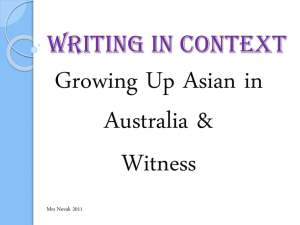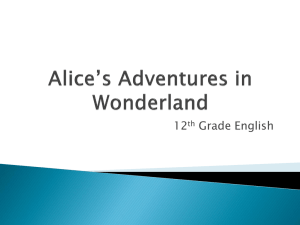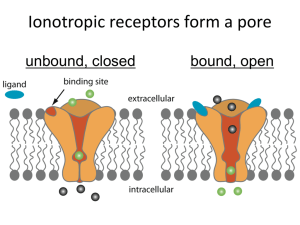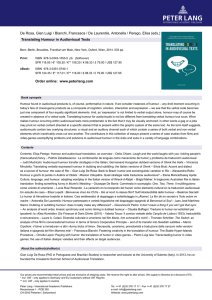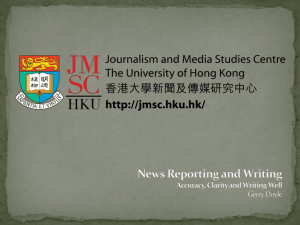Literary Techniques
advertisement
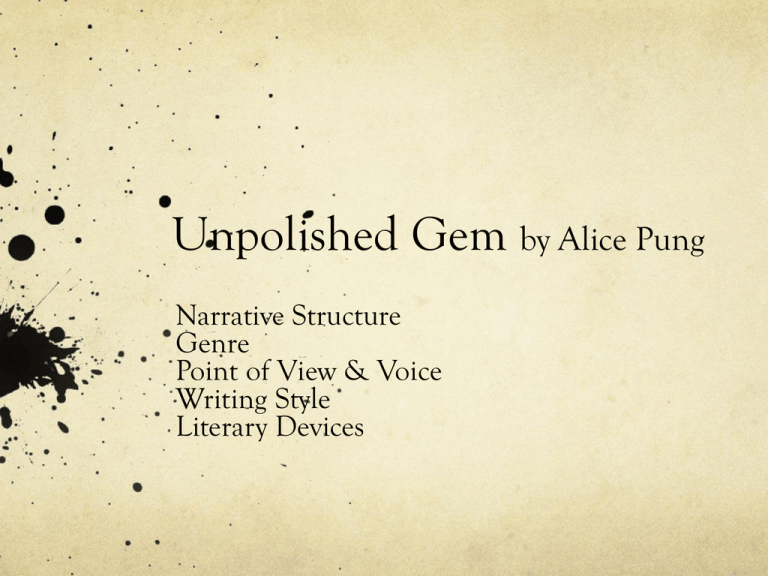
Unpolished Gem by Alice Pung Narrative Structure Genre Point of View & Voice Writing Style Literary Devices Narrative Structure This is not a straightforward chronological narrative of the lives of the Pungs. The telling begins in contemporary Australia and then interspersed are the stories of earlier lives of Alice’s parents and grandparents. The author has constructed the story of her family in Australia (with retrospective references to earlier lives in Cambodia and Vietnam) in distinct parts, each representing a stage in their lives and hers. The use of an epilogue and prologue serve as ‘parentheses’ that open and close the narrative. This provides readers with vital information about Alice and her family, as well as suggesting some kind of resolution to a storyline that might otherwise have appeared to be a series of episodes. Genre Creative nonfiction is factually accurate writing that pays attention to the craft of writing. This text belongs to the memoir category of this genre. A work is usually considered literary because of the way it’s written. A literary novel is more than simple storytelling. The writer pays special attention to language, word choice, rhythm, and voice. Memoir is a genre of writing truth which uses literary styles and techniques to create factually accurate narratives. It relies on the accuracy of the author’s recollections and must be verifiable. It is important to understand that the line between an authentic memory and a recreated past is not always clear. And in the process of constructing the narrative, an author may take some creative liberties with the facts. Genre Reading this story with the knowledge that it is a memoir alerts readers to the authenticity of the narrative voice and the experiences portrayed by the narrator. Memoir establishes a realistic setting that allows readers to consider the impact of the socio-political context of the era. Knowing that Pung’s story really happened might also encourage some readers to consider the themes more deeply as they imagine the lived experiences of this young girl growing up in a neighbourhood that actually exists. Point of View & Voice The fact that the text is created and based upon memories and stories told to the author, means that there is a limitation to the perspectives that we see throughout the text. Some characters are portrayed with great insight, while others are only considered from a distance. This is the result of the way which Alice Pung has chosen to write the text. It is not entirely omniscient, but insight is rather selective, depending upon the character she is writing about. Juxtaposition Pung generates juxtapositions between several characters and groups in order to highlight different aspects of integration and assimilation between migrants and native established Australian citizens. Mother and Father 1st Generation migrants children and the others Mother and Father Mother is unable to assimilate to the Australian way of life successfully due to the nature of her employment as an outworker. She is essentially off the grid. This isolation also inhibits her ability to grasp ‘the English’, which further marginalizes her. In contrast, Father has managed to grasp the English language to a sufficient level, which has allowed him to interact in the community and workforce. He has taken on a franchise in Retravision, actively contributing the community, assimilating as a model – hardworking, tax-paying, English speaking - citizen. st 1 Generation Migrant Children Apart from the fact that they are attending school alongside other “Australian” students, dress in the same clothes and speak (fluently) the same language, there is still an inherent divide between those 1st generation migrant children and others. Pung juxtaposes these two groups during the graduation dinner, where the distinction becomes clear. In spite of everything the parents have done to assimilate their children into the Australian culture, they are still outsiders. Style of Writing Pung writes in a style that captures the idiom of Australian speech along with the lyricism of eloquent prose. “Bugger it, why couldn’t I have something simple and spontaneous and not-so-serious? Bugger, bugger, bugger”. (p.231) “And so the door closes, and the Proletarian Princess walks sadly back into the house, realising that there are no Proletarian Princesses anyway and how could she possibly have been so think as to imagine that Dream Lover would come rescue her from here in the first place?” (p.98) This juxtaposition of elements serves as a constant reminder of the narrator’s intelligence and the cultural influences to which she is exposed. The Power of Language One of the threads running through this text is an exploration of how powerful language can be, how adaptable, and yet how it can exclude and divide. P2 gives us wonderful examples of one of the ‘Englishes’ that are evolving all the time. It raises the issue of the primary aim of language as functional. This is significant in terms of the difference between oral and written language, the storytelling skills of Alices’ grandmother and the communication barriers faced by her mother. P144 Shows that language is not just a matter of the words but the importance of the cultural context in which language is embedded and which shapes it. P180 Refers to connections between language, culture and beliefs and cross-cultural associations. Alice Pung also uses a variety of language techniques to assist in conveying her message of Assimilation, Integration and Cultural Diversity. Vivid Writing/Imagery Pung uses highly descriptive language in order to draw the reader into the text and assist them in seeing the world through different eyes (including those of Agheare/Alice). “My father’s moment is lost when a middle-aged woman with Maggi-noodle curls points at the man behind the counter with a flailing forefinger…” (p. 2) “In Teochew the word sounded benign, like the careful imprint of a calligraphy brush, not the heavy finality of the English Stroke.” (p. 170) ‘I was just festively plump.’ (p.57) ‘a turnip-and-carrot-soup sort of existence.’ (p.136) Simile p10 ‘My father...growing larger and larger as he approaches the top with a smirk pasted on his face, like a slow zoom in a cheesy Chinese film.’ p11 ‘She thinks about the ones back home who are unprocessed and waiting to be processed, unlike the meat that is stacked in tins of twelve in front of her.’ p13 ‘I have a clump of black hair plastered to my head like a Beatle circa the early 60s.’ p162 ‘...her handwriting tumbled down the blue lines like Kamikaze pilots.’ p170 ‘In Teochew the word sounded benign, like the careful imprint of a calligraphy brush, not the heavy finality of the English Stroke.’ Symbolism We can read into some of the imagery used by Pung throughout the text, as being symbolically representative of some of the key themes of Freedom and Autonomy derived from living in a democratic society after escaping from a totalitarian regime. “Ah, this wondrous new country where children are scared of dying because they have swallowed some Spearmint Wrigley’s, not because they stepped on a condensed-milk tin filled with ammunition!” (pp. 3-4) “‘The cars stopped for that old one!’ my grandmother cries. Tic-tic-tic goes the traffic light, and as the green man flashes, the old man casts a suspicious look at the crew pointing at him before hobbling away quickly to the other side of the road.” (p. 8) “The little Green Man was an eternal symbol of government existing to serve and protect. And any country that could have a little green man flashing was benign and wealthy beyond imagining.” (p.9) Humour & Tone As well as having an original turn of phrase and evocative imagery, Pung is able to use humour to engage the audience and engender a greater sense of warmth and empathy for the protagonist and other central characters. “She made the most of the words she still had by delivering them at ten million decibels in the car”. ((p.146) The use of sardonic humour subverts the conventional migrant misery story while also challenging the simplistic migrant success story. “My grandmother pads along in a light-blue pyjama suit she has sewn herself. A pair of sunglasses sits on top of her head-a second pair of eyes gazing skywards, beseeching the Lord Buddha to bless St.Vincent and his kind fraterity for vesting the family with such finery.” (p.7) Humour & Tone Pung employs witticisms to everyday situations, thereby transforming the mundane while drawing attention to the ironic aspects of life. ‘I was Chinese Ronald McDonald, minus the Happy Times’. And later. ‘What do you think you’re doing in the car?’ cried my mother. ‘Fermenting? Get out now.’ (p.63) Her satirical tone invites readers to question and critique the many serious issues raised within her anecdotes. At times this kind of humour seems to be mocking or scornful, yet the candid nature of these observations further serves to alert readers to issues that perhaps might require more critical consideration. Humour & Tone Bridging both cultures, Alice/Agheare is acutely aware of the stereotypes that prevail and impact her own efforts for acceptance and belonging. ‘A few more outdoor dates and Jim’s Mowing would be out of business.’ (p.235) At times her humour is self-deprecating, reminding us of her resilience despite a seemingly fragile self-image. ‘Going out with him would transform me into Woody Allen with a black wig.’ (p.231) Humour & Tone Yet Alice (the author) does not adopt a moralising tone and often depicts her family as quaint, without being patronising or demeaning. Mao-Bin U. ‘Their pronunciation made the place sound like a shonky university in China for discarded communists...’ (p.233) This light-hearted tone enables the author to share painful experiences and convey powerful messages without alienating readers or condemning individuals and society as a whole. “I had spent my childhood with a grandmother who packaged me into padded Mao suits and made me aware that I had to defend myself against all the other blandly dressed banana children-children who were yellow on the outside but believed they could never be completely white inside.” (p.214)

